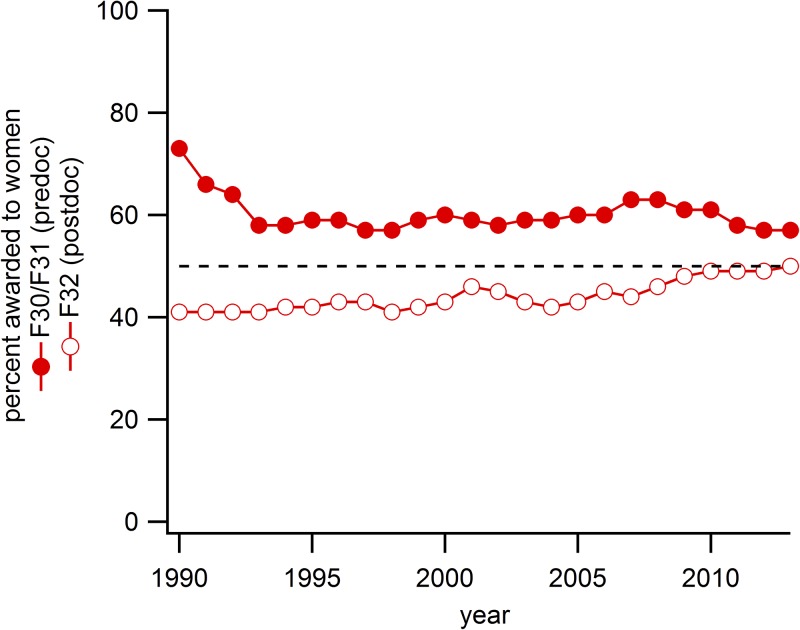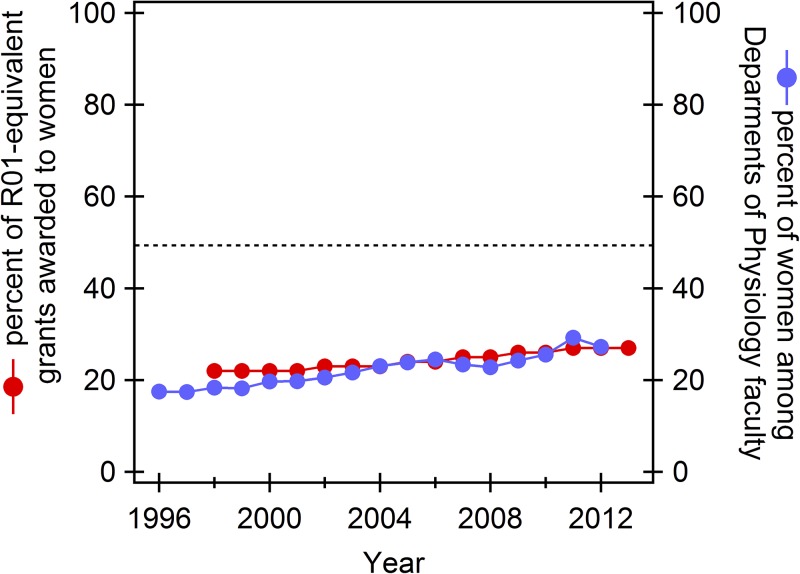The National Institutes of Health (NIH) recently released their DataBook for 2013 (National Institutes of Health DataBook, 2013), a laudable effort to increase the transparency of who applies for and is awarded grants. Dr. Jeremy Berg, former director of the National Institute of General Medical Science, deserves a shout-out for instigating the release of data used to drive decisions of funding and policy. He has continued that effort as president of the American Society of Cell and Molecular Biology. Dr. Sally Rockey, deputy director of Extramural Research at NIH, has transformed communication between NIH and the scientific community with her Rock Talk blog, which explains NIH policies and practices in plain language. These efforts to increase transparency at the NIH allow us to better understand the forces that have so much impact on our current and future work.
One section in the new DataBook pertains to data on grant funding analyzed by gender. Women constitute at least half of our graduate students and postdoctoral fellows; Fig. 1 shows that women receive about half of all individual graduate and postdoctoral fellowships in the F30/F31 and F32 grant mechanisms, respectively. In fact, women have made up about half of these awardees for more than 20 years! If the fraction of female F-grant awardees is a reasonable surrogate for the fraction of female trainees in general, these data suggest that women have had at least 20 years of advancing through the ranks in sufficient numbers so that by now we should see evidence of equity at the assistant, associate, and full professor levels.
Figure 1.
More than half of individual postdoctoral fellowships (F32) and nearly half of individual graduate fellowships are awarded to women. National Institutes of Health DataBook (2013).
But that is not the case. The long-standing gender parity among trainees has not led to parity among faculty, as demonstrated by the lack of women who receive R01-equivalent grant awards. Fig. 2 (red symbols) shows the percentage of R01-equivalent grants awarded to women, taken from the NIH DataBook, from 1998 through 2013. The low representation of women could reflect either a small fraction of grant proposals submitted by women or a disproportionally low success rate. Here, the NIH DataBook again has the answer. In the time period reported, the success rates for new R01-equivalent applications were indistinguishable for male and female applicants, so the lack of parity must be the result of fewer women having submitted proposals. Although the success rates for competitive renewal applications were consistently about four percentage points higher for male than for female applicants, this difference is nowhere near enough to explain why just under 30% of R01-equivalent grant awards are made to female principal investigators.
Figure 2.
Representation of women among the faculty in departments of physiology (blue; from the Surveys by the Association of Chairs of Departments of Physiology) and among recipients of R01-equivalent grant awards (red; from National Institutes of Health DataBook, 2013).
The NIH covers a very broad spectrum of research, from the effects of social media on health behaviors to single-molecule structural studies. Does the poor representation of women among NIH researchers extend to physiology? It does. An analysis of records posted on the website of the Association of Chairs of Departments of Physiology (http://www.acdponline.org/Surveys.htm) indicates that physiology’s lack of gender parity is typical of that observed pan-NIH. The blue symbols in Fig. 2 represent the percentage of faculty in departments of physiology who are female. In each year, the total number of faculty (men plus women) exceeded 800.
The glacial movement toward parity in the representation of women among R01-equivalent grant recipients and faculty in departments of physiology is unacceptable. Over the 15 years covered by the DataBook, the percentage of R01-equivalent grants awarded to women increased from 22 to 27%, a rate of 0.33 percentage points per year. The percentage of faculty in departments of physiology who are female increased from 17% in 1996 to 27% in 2012, a rate of 0.6 percentage points per year. If these trends continue, it will take 69 more years and 38 more years to reach parity in R01-equivalent awards and departments of physiology, respectively.
Women who apply for tenure-track faculty positions in the natural sciences at Research Universities with Very High Research Activity (formerly known as R1 Research Universities; Carnegie Classification of 2005 and 2010, http://classifications.carnegiefoundation.org/) are hired at rates at least as high as men (Ceci and Williams, 2011; Kaminski and Geisler, 2012). If this is also true for physiology, it means that nearly the entire leak in the pipeline occurs at the transition between the postdoctoral period and junior faculty. The majority of graduate students are female and almost half of postdoctoral fellows are female (Fig. 1). Many of these women do not apply for tenure-track positions at top-ranked research institutions (Ceci and Williams, 2011), something that must be addressed if faculty diversity at such institutions is to increase.
Qualitative research suggests that many women decide fairly early in their graduate training to opt out of the academic career track (Wellcome Trust, 2013). Interventions to achieve gender parity in academia must therefore start no later than graduate school and should continue at least through women’s decision to apply for faculty positions. This conclusion is not original, and numerous efforts are currently underway to diversify faculty, many of which were developed with funding from the National Science Foundation ADVANCE program (2013). However, I believe that a secondary consequence of the gender disparity must also be recognized and addressed.
The legacy of an academic scientist is based, at least in part, on the success of his or her trainees. Trainees who go on to work in education, industry, and science policy are all part of that legacy, but those who forge independent careers in academia are the ones expected to enhance their mentor’s academic reputation the most. This dependence of a mentor’s academic reputation on the career choices of his or her trainees incentivizes providing the best mentoring to those trainees who appear most likely to succeed in academia. Given that women leave the academic track at nearly twice rate of men, it makes sense to bet on men and offer them plum mentoring resources.
An implicit bias that is built into the discourse of a successful scientist will by definition go unnoticed, unacknowledged, and unchallenged (Gee, 2011). Male and female faculty are equally susceptible to implicit gender bias and have been shown to exhibit judgment tainted by implicit gender bias at equal rates (Moss-Racusin et al., 2012; Wellcome Trust, 2013). If we were aware of such gender bias in ourselves, we would surely not tolerate it.
Implicit bias undermines efforts to achieve gender parity in science faculty, and it is self-perpetuating. The more we direct mentoring resources disproportionately to men over women, the greater the disparity between men and women in aspiring to independent faculty positions. This leads to an applicant pool for faculty positions in which men outnumber women by more than two to one (Ceci and Williams, 2011; Wellcome Trust, 2013). The consequent enrichment of our faculty population with men validates and reinforces the unconscious disproportionate allocation of mentoring resources to male trainees.
As a scientist who is a woman, I believe that my every professional step is affected by my gender. No matter where I am or what I do, my perception is that I am seen as a woman scientist rather than as a scientist. When I face rejection, I wonder whether gender bias played a role. When I succeed, I ask myself whether I have received favored treatment as a minority. In a conference room full of male speakers, I feel that I don’t belong. Yet I find it unbearable to be the token woman. Even institutional efforts meant to evaluate diversity issues in order to address them can problematize female gender, as does the title of the National Science Foundation Report, “Women, Minorities, and Persons with Disabilities in Science and Engineering: 2013” (National Science Foundation ADVANCE Program, 2013). When I earned my PhD in 1993, I was not aware that I would be a pioneer. Hadn’t first- and second-wave feminism already transformed academic culture to create a level playing field and a welcoming culture? The data in Fig. 2 tell me that the burden of pioneering will be borne by female graduate students and postdoctoral fellows of today, as well as by those of the next decade, and the next, and the next.
Achieving gender equity will require a cultural change in the academic workplace. The first goal is for both men and women to recognize implicit and explicit bias in their actions. I believe this will require vigilance and many uncomfortable conversations. I’ve certainly had my share of conversations in which I’ve exhibited a tone-deaf lack of sensitivity when asking a colleague whether gender bias may have contributed to an action. I also am sure that I would similarly take offense if challenged on my own actions. I think we must risk offending each other as we figure out how to address bias without showing judgment. We need to face our imperfections if we are to become practiced at noticing discriminatory allocation of our resources. As part of this cultural soul searching, we must also rethink policies and practices that, although not biased in intention, result in the loss of diversity.
I believe that we have an advantage in the academy, in that having our assumptions challenged is business as usual. If I can’t justify my assumption that action X was free from bias then it probably wasn’t. My scientific training allows me to apply objective thinking to even the workings of my own mind. I’d like to see the potential of bias as an acceptable topic of conversation to which we can devote our most powerful analytical skill and our most clever thinking.
Although I’ve discussed implicit gender bias here, biases against other groups also decrease the diversity of faculty in departments of physiology and other scientific communities. The value of a diverse faculty is undisputed. Our efforts thus far have, in large part, failed to produce the meaningful demographic changes required to achieve a faculty that looks like the population as a whole. In addition to further institutional change, each of us must take personal responsibility for identifying our implicit biases, acknowledging their potential for harm, and seeking out ways to ensure our actions reflect only the values of fairness and justice that we all share.
References
- Ceci S.J., Williams W.M. 2011. Understanding current causes of women’s underrepresentation in science. Proc. Natl. Acad. Sci. USA. 108:3157–3162 10.1073/pnas.1014871108 [DOI] [PMC free article] [PubMed] [Google Scholar]
- Gee J.P. 2011. An Introduction to Discourse Analysis: Theory and Method. Routledge, New York: 224 pp [Google Scholar]
- Kaminski D., Geisler C. 2012. Survival analysis of faculty retention in science and engineering by gender. Science. 335:864–866 10.1126/science.1214844 [DOI] [PubMed] [Google Scholar]
- Moss-Racusin C.A., Dovidio J.F., Brescoll V.L., Graham M.J., Handelsman J. 2012. Science faculty’s subtle gender biases favor male students. Proc. Natl. Acad. Sci. USA. 109:16474–16479 10.1073/pnas.1211286109 [DOI] [PMC free article] [PubMed] [Google Scholar]
- National Institutes of Health DataBook. 2013. http://report.nih.gov/nihdatabook/index.aspx (accessed June 17, 2014)
- National Science Foundation ADVANCE program. 2013. Women, Minorities, and Persons with Disabilities in Science and Engineering: 2013. http://www.nsf.gov/statistics/wmpd/2013/start.cfm (accessed June 17, 2014)
- Wellcome Trust. 2013. Risks and Rewards. How PhD students choose their careers: Qualitative research report. http://www.wellcome.ac.uk/stellent/groups/corporatesite/@sf_central_grants_admin/documents/web_document/wtp053947.pdf (accessed June 17, 2014)




